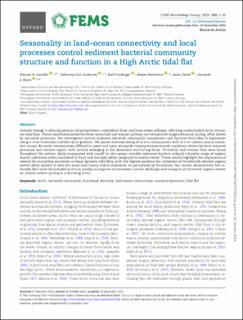| dc.contributor.author | Handler, Eleanor R. | |
| dc.contributor.author | Andersen, Sebastian | |
| dc.contributor.author | Gradinger, Rolf Rudolf | |
| dc.contributor.author | Mcgovern, Maeve | |
| dc.contributor.author | Vader, Anna | |
| dc.contributor.author | Poste, Amanda Elizabeth | |
| dc.date.accessioned | 2024-01-25T08:57:43Z | |
| dc.date.available | 2024-01-25T08:57:43Z | |
| dc.date.created | 2024-01-22T10:34:34Z | |
| dc.date.issued | 2023 | |
| dc.identifier.citation | FEMS Microbiology Ecology. 2023, 100 (1), fiad162. | en_US |
| dc.identifier.issn | 0168-6496 | |
| dc.identifier.uri | https://hdl.handle.net/11250/3113707 | |
| dc.description.abstract | Climate change is altering patterns of precipitation, cryosphere thaw, and land–ocean influxes, affecting understudied Arctic estuarine tidal flats. These transitional zones between terrestrial and marine systems are hotspots for biogeochemical cycling, often driven by microbial processes. We investigated surface sediment bacterial community composition and function from May to September along a river–intertidal–subtidal–fjord gradient. We paired metabarcoding of in situ communities with in vitro carbon-source utilization assays. Bacterial communities differed in space and time, alongside varying environmental conditions driven by local seasonal processes and riverine inputs, with salinity emerging as the dominant structuring factor. Terrestrial and riverine taxa were found throughout the system, likely transported with runoff. In vitro assays revealed sediment bacteria utilized a broader range of organic matter substrates when incubated in fresh and brackish water compared to marine water. These results highlight the importance of salinity for ecosystem processes in these dynamic tidal flats, with the highest potential for utilization of terrestrially derived organic matter likely limited to tidal flat areas (and times) where sediments are permeated by freshwater. Our results demonstrate that intertidal flats must be included in future studies on impacts of increased riverine discharge and transport of terrestrial organic matter on coastal carbon cycling in a warming Arctic. | en_US |
| dc.language.iso | eng | en_US |
| dc.publisher | Oxford University Press | en_US |
| dc.rights | Navngivelse 4.0 Internasjonal | * |
| dc.rights.uri | http://creativecommons.org/licenses/by/4.0/deed.no | * |
| dc.title | Seasonality in land–ocean connectivity and local processes control sediment bacterial community structure and function in a High Arctic tidal flat | en_US |
| dc.type | Peer reviewed | en_US |
| dc.type | Journal article | en_US |
| dc.description.version | publishedVersion | en_US |
| dc.rights.holder | © 2023 The Authors | en_US |
| dc.source.pagenumber | 20 | en_US |
| dc.source.volume | 100 | en_US |
| dc.source.journal | FEMS Microbiology Ecology | en_US |
| dc.source.issue | 1 | en_US |
| dc.identifier.doi | 10.1093/femsec/fiad162 | |
| dc.identifier.cristin | 2231695 | |
| dc.relation.project | Norges forskningsråd: 268458 | en_US |
| dc.source.articlenumber | fiad162 | en_US |
| cristin.ispublished | true | |
| cristin.fulltext | original | |
| cristin.qualitycode | 2 | |

